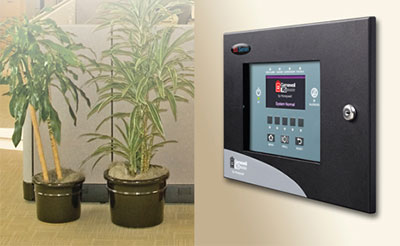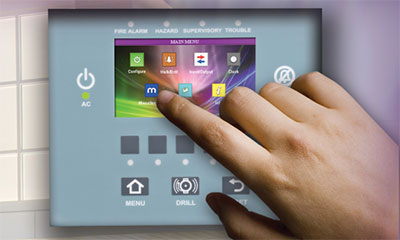The first time an end user – a facility manager, security guard or building owner – is faced with operating a fire alarm control panel could easily be in an emergency situation. In the midst of such a crisis, it is not the best time to determine which of 20 or 30 different buttons to push.  Overly complex fire alarm interfaces make users vulnerable to “floating finger syndrome” – their finger pauses in the air unsure which button to push, paralyzed by fear of selecting the wrong button with no guidance and no intuitive choices. In a time of high stress, the need to interface with complex fire alarm systems can undermine a user's confidence and work against rapid reaction that is critical to timely emergency response.
Overly complex fire alarm interfaces make users vulnerable to “floating finger syndrome” – their finger pauses in the air unsure which button to push, paralyzed by fear of selecting the wrong button with no guidance and no intuitive choices. In a time of high stress, the need to interface with complex fire alarm systems can undermine a user's confidence and work against rapid reaction that is critical to timely emergency response.
The problem becomes especially obvious if you listen to the “voice of the customer” and observe how end users react when tasked with operating a fire alarm panel. Even people supposedly trained to use a panel may not remember what they learned during training several years ago when the building first opened. More often than not, the trained individual is not in the vicinity when an emergency occurs, and those who remain are baffled by the complexity of the fire alarm panel.
Putting untrained individuals in front of a fire alarm panel can bring out their “fear of the fire alarm.” After all, everyone is conditioned not to touch a fire alarm system. Listening to customers and observing how they use fire equipment can provide insights into the challenges of designing an easy-to-use, intuitive fire alarm panel interface.
Many end users admit they haven't touched the fire alarm system in five years or more. But what happens if he or she is the only person around during an emergency? Security personnel, who are responsible for the safety of a building, may be shocked to learn how unprepared their people are in case of an emergency. A lag in response could have a precious cost in terms of time, lives and property.
An overarching and crippling, concern is: What might happen if I push the wrong button? One factor in the more complex interfaces is the emergence of fire alarm systems that offer additional features and functionalities, each controlled by a different series of buttons. Greater functionality should not be realized at the expense of usability.
Human Factors and Touch Screens
Today’s solution is to incorporate more human factors into fire alarm control panel design, including a more intuitive, touch-screen display. However, the industry has been slow to adopt new touch-screen technology, stalled by codes and standards that can stifle innovation. Touch screens have also emerged more rapidly on higher-end systems, although smaller and mid-market systems have just as much need for them - and just as much at stake.
 Why must fire alarm panels require a person using them to know exactly which button to press? A touch screen interface can help direct an end user to what's important in an emergency. A touch screen can help guide a user to the correct response, with no guessing. Users can operate touch screen panels with greater confidence – and even figure it out on the fly.
Why must fire alarm panels require a person using them to know exactly which button to press? A touch screen interface can help direct an end user to what's important in an emergency. A touch screen can help guide a user to the correct response, with no guessing. Users can operate touch screen panels with greater confidence – and even figure it out on the fly.
In an emergency situation, the end user typically needs to know several key pieces of information:
- Where's the alarm?
- What type of device is involved?
- Who do I call?
- How do I silence the buzzer?
They want to deal with the fire alarm panel and then move on to making other emergency decisions. Holding simulated emergency events can help end users pinpoint any problems they have interfacing with a fire alarm panel.
In the last few years, the codes and standards have changed to allow use of newer technologies like IP communications, wireless and Ethernet. With these technologies gaining acceptance, it allows the fire alarm industry to have more leeway to provide the end user a real-time assessment that offers more information than a simple report at the panel. Some areas of the country are still resisting change, but others are embracing the ability of fire alarm panels to offer additional information and functionality.
For dealers, a more intuitive fire alarm interface can eliminate nuisance calls and emergency service calls. No more calls in the middle of the night from people who are afraid to touch a fire alarm control panel when it goes into trouble. And hopefully, no need to send a service technician to a site just to reset the panel.
Use of an understandable interface with a familiar design increases the likelihood an end user will make the proper selection during an emergency.
Simplicity is Key
Just within the last several years, touch screens have emerged as a familiar part of everyday life. Customers see them on their smart phones and tablets, on GPS systems, at ATMs and movie rental kiosks. Car radios have transitioned to touch screens, as well. It's time that the fire alarm industry embraces these familiar new interfaces to eliminate uncertainty and ensure rapid end user response in emergency situations.
Fear of fire is understandable and well advised, but end users shouldn't be afraid of operating their fire alarm systems.